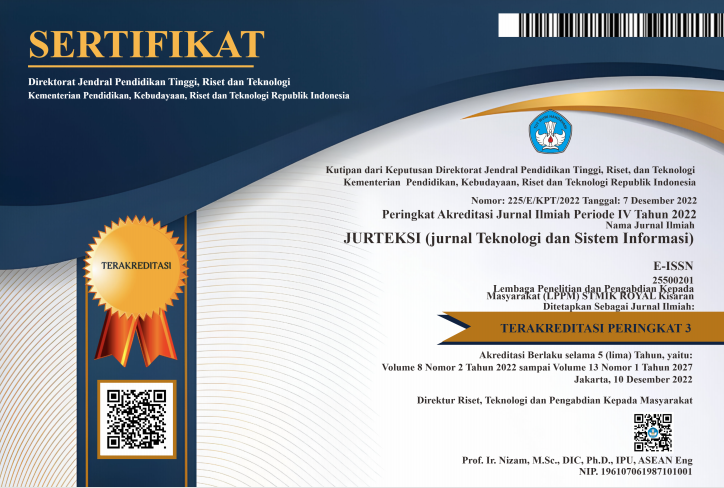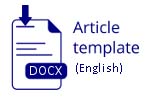FORECASTING GAMIS DEMAND IN FASHION GALLERY USING WEIGHTED MOVING AVERAGE
Abstract
Abstract: This research will discuss predictions of demand for robes at the Fashion Gallery. The problem that occurs is that there is often a buildup in the number of robes provided in shops, thereby increasing additional expenses, such as storage costs and demand costs. On the other hand, if there is too little stock of robes, it will result in losses because potential buyers do not get the items they need. In this case, the forecasting system will be used as a tool to solve the problem of robe accumulation. The WMA method prioritizes the most recent data points while smoothing out fluctuations. The advantage of this method is increased responsiveness to recent changes in demand patterns, contributing to more accurate forecasts by considering current information more prominently than historical data. By implementing the WMA method, it is hoped that the accumulation of robes can be avoided. From the results of prediction calculations in January 2024, it is predicted that there will be 143 adult robes, with a MAD of 7.685185, MSE 74.79938 and MAPE 5%. For small children's robes, it is predicted that there will be 56 shirts, with MAD of 8.388889, MSE of 91.16358 and MAPE of 12%. It can be concluded that the WMA method can make it easier for Fashion Gallery to predict demand for adult and children's robes in the following month.
Keywords: forecasting; robe request; weighted moving average
Abstrak: Dalam penelitian ini akan membahas prediksi permintaan baju gamis pada Fashion Gallery. Permasalahan yang terjadi sering terjadinya penumpukan pada jumlah baju gamis yang disediakan pada toko, sehingga meningkatkan beban tambahan, seperti biaya penyimpanan dan biaya permintaan. Sebaliknya, apabila stok gamis yang terlalu sedikit, mengakibatkan kerugian yang disebabkan karena calon pembeli tidak mendapatkan barang yang dibutuhkan. Dalam hal ini sistem forecasting akan digunakan sebagai alat bantu dalam menyelesaikan permasalahan penumpukan baju gamis. Metode WMA, lebih mementingkan titik data terkini sambil memperlancar fluktuasi. Kelebihan metode ini meningkatkan daya tanggap terhadap perubahan pola permintaan terkini, berkontribusi pada perkiraan yang lebih akurat dengan mempertimbangkan informasi terkini secara lebih menonjol dibandingkan data historis. Dengan diterapkannya metode WMA, diharapkan dapat menghindari terjadinya penumpukan baju gamis. Dari hasil perhitungan prediksi pada bulan Januari 2024, untuk baju gamis dewasa diprediksi sebanyak 143 baju, dengan MAD sebesar 7.685185, MSE 74.79938 dan MAPE 5%. Untuk baju gamis anak kecil diprediksi sebanyak 56 baju, dengan MAD sebesar 8.388889, MSE 91.16358 dan MAPE sebesar 12%. Dapat disimpulkan bahwa metode WMA dapat memudahkan Fashion Gallery dalam meramalkan permintaan baju gamis dewasa dan anak-anak pada bulan berikutnya.
Kata Kunci: forecasting; permintaan baju gamis; weighted moving average
References
N. Fatmawati, “Gaya Hidup Mahasiswa Akibat Adanya Online Shop,†J. Pendidik. Ilmu Sos., vol. 29, no. 1, pp. 29–38, 2020, doi: 10.17509/jpis.v29i1.23722.
W. Nst, M. Yafiz, and S. Ramadhani, “Dampak Bisnis Fashion Online Terhadap Tingkat Pendapatan Pedagang Di Pasar Petisah Medan,†J. Islam. Circ., vol. 2, no. 2, pp. 32–46, 2021.
N. Aslami, “PENDIDIKAN PEREMPUAN BERBUSANA MUSLIMAH,†2022.
D. Insan Muchtadi Syafiq, “Perancangan Sistem Penjualan Baju Gamis Pada Toko a&a Fashion Berbasis Php Mysql,†Semin. Nas. Teknol. Inf. dan Komun. STI&K, vol. 7, p. 9, 2023.
R. Sindia, I. K. Siregar, and M. Ihsan, “FORECASTING THE AMOUNT OF DODOL SALES USING THE WMA METHOD,†JURTEKSI (Jurnal Teknol. dan Sist. Informasi), vol. VIII, no. 3, pp. 285–294, 2022.
A. Rahayu, A. Lattu, and M. Mupaat, “Analysis of Product Stock Inventory Forecasting Using Weighted Moving Average Method,†J. Tek. Inform., vol. 3, no. 6, pp. 1631–1638, 2022, doi: 10.20884/1.jutif.2022.3.6.421.
H. Syafwan, P. Putri, and M. Syafwan, “Forecasting Unemployment in Indonesiausing Weighted Moving Average Method,†JURTEKSI (Jurnal Teknol. dan Sist. Informasi), vol. 9, no. 4, pp. 699–706, 2023, doi: 10.33330/jurteksi.v9i4.2624.
E. Martantoh and E. Agustina, “PENDUKUNG KEPUTUSAN STOK BARANG MENGGUNAKAN METODE WMA,†SIMANTIK, vol. 16, no. 4, pp. 327–332, 2021, doi: 10.22141/22240721.16.4.2020.208486.
B. Syahputri, A. P. Lubis, and S. Andriyani, “Prediction of 35,000 All Clothes Sales Range Using Wma Method,†JURTEKSI (Jurnal Teknol. dan Sist. Informasi), vol. 8, no. 3, pp. 335–342, 2022, doi: 10.33330/jurteksi.v8i3.1733.
T. S. Gunarti, B. Tujni, and I. Solikin, “Implementation of E-Forecasting on Jimmy Fish Using the Wieghted Moving Average Method,†JURTEKSI (Jurnal Teknol. dan Sist. Informasi), vol. 9, no. 2, pp. 183–188, 2023, doi: 10.33330/jurteksi.v9i2.1864.
S. Nurhayati and A. Syafiq, “Sistem Prediksi Jumlah Produksi Baju Menggunakan Weighted Moving Average,†J. Manaj. Inform., vol. 12, no. 1, pp. 14–24, 2022, doi: 10.34010/jamika.v12i1.6680.
I. Solikin, S. Hardini, F. E. Citra Sari, and C. M. Chaiago, “Membangun Aplikasi WMA dan SMA Sebagai Support System,†J. Bumigora Inf. Technol., vol. 4, no. 1, pp. 107–114, 2022, doi: 10.30812/bite.v4i1.1938.













